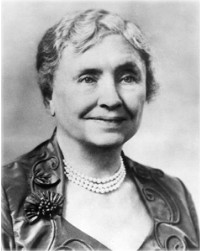Helen Keller biografia
Helen Adams Keller (ur. 27 czerwca 1880 w Tuscumbia, Alabama, zm. 1 czerwca 1968 w Westport, Connecticut) – amerykańska głuchoniewidoma pisarka.
Mając 19 miesięcy przeszła chorobę, która pozbawiła ją wzroku i słuchu. Kiedy miała 6 lat, jej rodzice poprosili o konsultację Aleksandra Grahama Bella. Ten skontaktował ich z Ann Mansfield Sullivan (później A.M. Macy), która zaczęła kształcić Helen. Pod opieką Sullivan Helen robiła ogromne postępy. Nauczyła się alfabetu Braille’a i studiowała w Horace Mann School for the Deaf (w Bostonie). Poświęciła życie innym osobom upośledzonym. Napisała wiele książek, z których najsławniejsza to The Story of My Life (1902), wydana po polsku w 1904 pt. Historia mego życia. Sztuka Williama Gibsona oparta na życiu Keller i Sullivan zdobyła Nagrodę Pulitzera w 1960, została też sfilmowana (po raz pierwszy w 1962 – Cudotwórczyni).

źródo i zdjęcie: wikipedia
“Historia mego życia” – Helen Keller
cytaty Helen Keller:
Helen Keller
“Nie wolno zgadzać się na pełzanie, gdy czujemy potrzebę latania”.
Helen Keller
“Słowa są skrzydłami umysłu”.
Helen Keller
“Miłość – to, co każdy czuje do innych”.
Helen Keller
“Gdy zamykają się jedne drzwi do szczęścia, otwierają się inne, ale my patrzymy na pierwsze drzwi tak długo, że nie widzimy tych drugich”.
Helen Keller

Born: Jun. 27, 1880 – Tuscumbia, Alabama, USA
Died: Jun.1, 1968 – Arcan Ridge, Westport, Connecticut, USA
Born perfectly healthy with both sight and hearing, Helen suffered a mysterious illness when she was just 18 months old that left her both blind and deaf. Naturally, she became a difficult child with tantrums and outbursts that terrorized her family. When she was six, her mother contacted Alexander Graham Bell, at the time a teacher of deaf children, for help. He recommended that she contact the Perkins Institution and find a teacher for Helen. They in turn suggested a recent graduate, Anne Sullivan. Sullivan eventually taught Helen the meaning of words through the use of a sign language based on touch. Helen’s ability to learn was astounding, and in a short time she had mastered this technique. In 1894, Helen attended the Wright-Humanson School for the Deaf in order to improve her limited abilities at speech. In 1896, she attended the Cambridge School for Young Ladies and in 1900, entered Radcliffe College. It was while still a student that she published her now classic The Story of My Life (1903). In 1904, Helen became the first deaf-blind person to earn a degree at a US college. Helen continued to live with Anne even after Anne’s marriage in 1905. In 1909, she published The World I Live In and in 1913 Out of the Dark appeared which expounded Helen’s new-found socialist views in a series of essays; she had become a member of the Socialist Party of Massachusetts in 1909. Over the next 5 years, Helen toured the lecture circuit, but by 1918 demand had diminished and she settled in Forest Hills, New York with Anne and her husband. As Anne’s health began to deteriorate, Helen continued her work and fund raising with the help of Anne’s secretary, Polly Thomson. Together, they toured the world raising funds for the blind. When Anne died in 1936, Helen and Polly moved to Arcan Ridge in Westport, Connecticut. After the Second World War, Helen contiunued her world tours, but Polly’s health began to fail and by 1953, the tours came to an end. In 1955, Helen published Teacher, the story of Anne. Helen suffered a stroke in 1961 and was never completely recovered until her death in 1968. In 1964, she received the nation’s highest civilian decoration, The Presidential Medal of Freedom, and in 1965 she was elected to the Woman’s Hall of Fame. Her other published work includes Optimism (1903), A Chart of Darkness (1908), The Song of the Stone Wall (1910), My Religion (1927), Midstream – My Later Life (1930) and Peace at Eventide (1932).